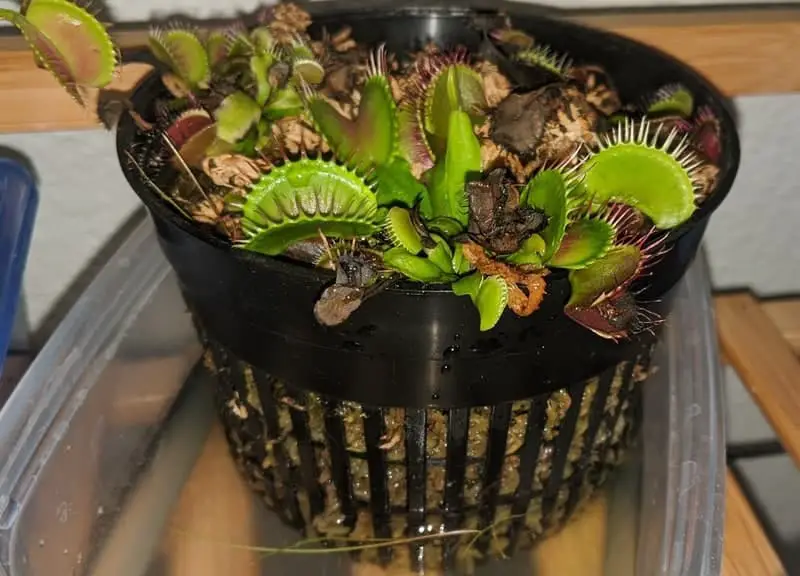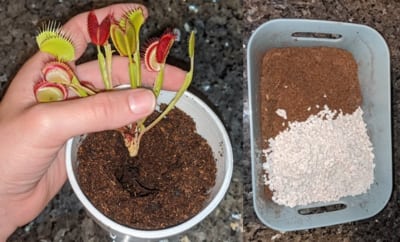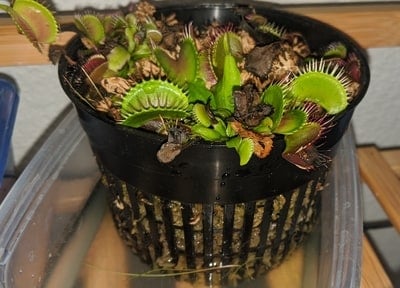I got alarmed when I noticed green algae growing in my Venus flytrap. I was concerned about the health of my plant. Luckily after some research and changes in my setup, I got great results.
Green algae can grow in Venus flytrap plants. Algae is not harmful to the plant but it can be a sign of poor growing conditions, such as excessive moisture and lack of appropriate light exposure.
This article will teach you exactly how to eliminate and prevent algae in your Venus flytrap.
Is Algae Harmful for Venus Flytraps?
In the wild, Venus flytraps grow in very humid, bog-like conditions. They require constant watering and exposure to lots of sunlight to be healthy. Due to their environmental requirements, it is common for some Venus flytrap owners to get algae on their plant. Algae grow where there are water and light, and venus flytraps grow in exactly that environment too.
The green algae growing in Venus flytraps usually lives in the water tray and the soil. Regardless, algae are harmless for the plant. Algae do not consume organic material; instead, it consumes wastes and produces food through photosynthesis.
Even though algae can’t harm Venus flytraps or other carnivorous plants directly, it can be a sign of poor growing conditions. Do not get too concerned with algae, but make sure to review the later section to verify your plant’s setup. We will be checking for the following:
- Correct watering frequency
- Proper light exposure

The Venus flytrap in the picture is potted in pure sphagnum moss. The plant is healthy, but there is green alga growing in the tray and in the potting media.
Algae Removal Options for Venus Flytraps
Even though Algae can’t kill your plant, most people are eager to remove it due to aesthetics. The potting media can start to look green and slimy and have a very unappealing look.
The most straightforward method to remove the algae is to repot the plant. However, repotting can weaken your plant for several weeks and can be avoided if it is not required. Before choosing the repotting option, you can try two things:
- Empty the water tray of your plant and clean it.
- Place your plant under strong sunlight.
Sometimes the algae start to appear in the plant’s water tray. When the algae are just starting to grow, removing it can be easy. Empty the water tray and wash it thoroughly. Then, use distilled water (or reverse osmosis or rainwater) to refill it. Observe the water in the next few days to verify it is gone. If it is still there, continue to the next strategy: strong sunlight.
Strong direct sunlight can eliminate algae. Venus flytraps benefit greatly from proper exposure to sunlight, exposing the plant to extra light will be beneficial to eliminate algae and to promote growth. Place your plant outdoors under direct sunlight, preferably for more than six hours a day. After a couple of weeks, the algae should have reduced or disappeared. When placing your plant under direct sunlight, make sure the temperature is not above the recommended limits. Temperatures above 95 F (35 C) can be harmful to your plant.
If a combination of strong sunlight and cleaning the water tray is not enough, the last option is to repot. Here are the repotting instructions:
- Gather fresh Venus flytrap soil and at least a few cups of pure water. Also, it helps to have a spray bottle filled with pure water.
- Losen up the soil in the edges of the pot and remove the Venus flytrap. The Plant will be covered with dirt throughout the roots.
- Clean the pot and water tray very well. You can reuse the same container, but it must be sparkly clean.
- Use the water and the spray bottle to loosen up the soil attached to the plant’s roots. Carefully remove all of it. Be patient during this step and make sure to treat the rhizome (white bulb) carefully. After the soil is all out, rinse the root and the plant one more time.
- Moisten the fresh soil with the pure water source. I personally always use distilled water.
- Grab the soil and introduce it in the container until it is topped off.
- Grab a slim tool like a pencil, a stick, or fingers to make a vertical hole in the pot. Then, you will introduce the roots in the hole, so make it deep enough. The roots of Venus flytraps are long.
- Introduce the plant’s roots in the hole and push the soil together with your fingers until the plant is secure. The rhizome should be partially underground, while the growth points remain on the surface.
- Water the soil after potting to set the dirt in the pot.
- Follow the algae prevention instructions below to prevent any future algae issues.

The instructions are a summary of how to repot a Venus flytrap. However, there is more information about soil options and repotting tips that can help complete this process. I wrote an article on potting techniques, to sum up, all the necessary information. Make sure to read it!
Algae Prevention for Carnivorous Plants
Venus flytraps benefit from high moisture environments. They thrive in high humidity regions. As a result, they require above average watering levels. In this section, you will learn how to prevent excessive moisture that leads to algae growth.
There are three main consideration you can follow to prevent another algae episode:
- Water thoroughly but avoid overwatering (and standing water)
- Expose your plant to direct sunlight
- Choose a soil with good drainage
Now, an explanation of each item:
1. Water Thoroughly but Avoid Overwatering (and Standing Water)
Watering Venus flytraps is essential for their survival. When carnivorous plants dry out, they suffer, and they can die very quickly. Water Venus flytraps often to keep the soil moist at all times, but not soaking wet.
If you use the water tray method, law the water in the tray to dry before filling and never fill the water tray with more than an inch of water.
Keep your Venus flytrap watered and happy, but avoid overwatering and standing water. You can perfect your watering technique by reading this article: Venus Flytrap Watering Process. The article details the watering process and helps you prevent mold and water issues.
2. Expose Your Plant to Direct Sunlight
Venus flytraps exhibit exemplary growth when grown outside. Grow your plant outdoors to prevent algae. Direct sunlight kills algae and prevents the growth of bacteria or microorganisms. As long as the temperature remains below 95 F (35 C), Venus flytraps will be able to handle the weather.
3. Choose a Soil With Good Drainage
Not all carnivorous plant soil is the same. Some soil options are more suitable to retain moisture while allowing for proper drainage. Since Venus flytraps live in very moist conditions, soil selection is important.
You can employ pure peat moss or sphagnum moss to grow Venus flytraps. However, pure moss media does not always drain properly. For best results, employ a mix of moss with perlite or sand. Both elements provide drainage and aeration. Suppose you are unfamiliar with the soil options. I have an article that describes all the soil considerations. It also provides recipes on how to make A grade carnivorous plant soil.
Algae vs Mold in Venus Flytraps
Algae is very different from mold, especially in the effects they produce in Venus flytraps.
The presence of algae is harmless for Venus flytraps. But, mold can cause many issues such as root rot. Soggy environments cause both algae and mold. However, mold does feed on organic matter and can attack the root system.
The 3 recommendations in the previous section are also recommendations to prevent mold, which can be harmful.
Final Thoughts
It easy to freak out any time there are changes on your Venus flytrap. At the end of the day, Venus flytraps are not the most conventional plants; they have specific requirements. Luckily algae is not a life-death situation. It is best not to have it, but you can live with it.
For more information on Venus flytrap care, make sure to download a free care sheet attached to this article: Ultimate Venus Flytrap Care Guide.


